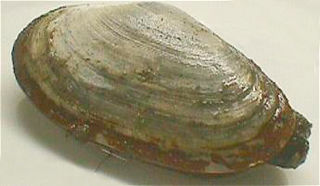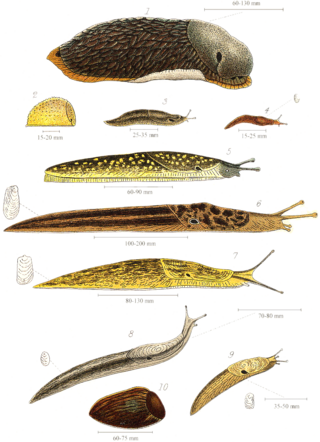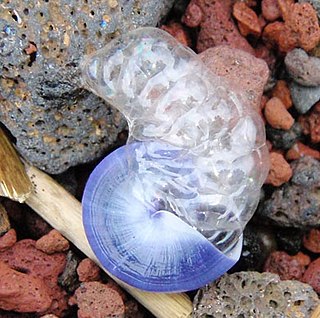
Loris is the common name for the strepsirrhine mammals of the subfamily Lorinae in the family Lorisidae. Loris is one genus in this subfamily and includes the slender lorises, Nycticebus is the genus containing the slow lorises, and Xanthonycticebus is the genus name of the pygmy slow loris.

The superfamily Apoidea is a major group within the Hymenoptera, which includes two traditionally recognized lineages, the "sphecoid" wasps, and the bees. Molecular phylogeny demonstrates that the bees arose from within the traditional "Crabronidae", so that grouping is paraphyletic, and this has led to a reclassification to produce monophyletic families.
Volutoidea is a taxonomic superfamily of predatory sea snails, marine gastropod mollusks in the clade Neogastropoda.

Asaphida is a large, morphologically diverse order of trilobites found in marine strata dated from the Middle Cambrian until their extinction during the Silurian. Asaphida contains six superfamilies, but no suborders. Asaphids comprise some 20% of described fossil trilobites.

Rissooidea is a superfamily of tiny marine snails.

Stylommatophora is an order of air-breathing land snails and slugs, terrestrial pulmonate gastropod molluscs. This taxon includes most land snails and slugs. Stylommatophorans lack an operculum, but some close their shell apertures with temporary "operculum" (epiphragm) made of calcified mucus. They have two pairs of retractile tentacles, the upper pair of which bears eyes on the tentacle tips. All stylommatophorans are hermaphrodites.

Cicadomorpha is an infraorder of the insect order Hemiptera which contains the cicadas, leafhoppers, treehoppers, and spittlebugs. There are approximately 35,000 described species worldwide. Distributed worldwide, all members of this group are plant-feeders, and many produce either audible sounds or substrate vibrations as a form of communication. The earliest fossils of cicadomorphs first appear during the Late Permian. Notable extinct members include the "giant cicadas" belonging to Palaeontinidae.

Myida is an order of saltwater and freshwater clams, marine and freshwater bivalve molluscs in the subclass Heterodonta. The order includes such bivalves as soft-shell clams, geoducks and shipworms.

Polyceroidea is a taxonomic superfamily of sea slugs, specifically dorid nudibranchs, marine gastropod mollusks in the clade Doridacea.

Trochoidea is a superfamily of small to very large vetigastropod sea snails with gills and an operculum. Species within this superfamily have nacre as the inner shell layer. The families within this superfamily include the Trochidae, the top snails. This superfamily is the largest vetigastropodan superfamily, containing more than 2,000 species.

Slug, or land slug, is a common name for any apparently shell-less terrestrial gastropod mollusc. The word slug is also often used as part of the common name of any gastropod mollusc that has no shell, a very reduced shell, or only a small internal shell, particularly sea slugs and semi-slugs.

Vetigastropoda is a major taxonomic group of sea snails, marine gastropod mollusks that form a very ancient lineage. Taxonomically the Vetigastropoda are sometimes treated as an order, although they are treated as an unranked clade in Bouchet and Rocroi, 2005.

The Limacoidei is a taxonomic infraorder of air-breathing land snails, semislugs and slugs, terrestrial pulmonate gastropod molluscs in the suborder Helicina

Vanikoroidea is a superfamily of sea snails, marine gastropod molluscs in the clade Littorinimorpha. The superfamily Eulimoidea is a synonym of Vanikoroidea.

Epitonioidea is a superfamily of planktonic and ectoparasitic sea snails, marine gastropod molluscs within the informal group Ptenoglossa. This superfamily includes the wentletraps and the purple snails.

Archegosauroidea is an extinct superfamily of Permian temnospondyls. The superfamily is assigned to the clade Stereospondylomorpha and is the sister taxon to the suborder Stereospondyli. It includes the families Actinodontidae and Archegosauridae, and possibly the genus Intasuchus, which is placed within the monotypic family Intasuchidae. They were fully aquatic animals, and were metabolically and physiologically more similar to fish than modern amphibians.
A protein superfamily is the largest grouping (clade) of proteins for which common ancestry can be inferred. Usually this common ancestry is inferred from structural alignment and mechanistic similarity, even if no sequence similarity is evident. Sequence homology can then be deduced even if not apparent. Superfamilies typically contain several protein families which show sequence similarity within each family. The term protein clan is commonly used for protease and glycosyl hydrolases superfamilies based on the MEROPS and CAZy classification systems.

The Enthemonae is a suborder of sea anemones in the order Actiniaria. It comprises those sea anemones with typical arrangement of mesenteries for actiniarians.

Aphidomorpha is an infraorder within the insect order Sternorrhyncha which includes the aphids and their allies in the superfamilies Adelgoidea, Phylloxeroidea and Aphidoidea. This group also includes numerous fossil taxa of uncertain placement, such as these other superfamilies Triassoaphidoidea, Genaphidoidea, Palaeoaphidoidea, and Tajmyraphidoidea.

















